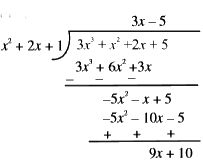A point charge +Q is place just outside an imaginary hemispherical surface of radius R as shown in the figure. Which of the following statements is/are correct ?

The electric flux passing through the curved surface of the hemisphere is −Q2ε0(1−1√2
The component of the electric field normal to the flat surface is constant over the surface
Total flux through the curved and the flat surfaces is Q0ε0
The circumference of the flat surface is an equipotential
The correct Answer is:A, D
Since the charge lies outside the hemi-sphere, net flux passing through the sphere is zero.
ϕcurved surface+ϕdisc=0
Option (C) is incorrect
ϕcurved surface=−ϕdisc
cosθ=R√R2+r2, ϕdisc=∫→E.d→A

=∫(14πε0Q(R2+r2)×2πrdr×cosθ)=Q.2π4πε0∫rdrR2+r2×R(R2+r2)1/2
=QR2ε0∫R0rdr(R2+r2)3/2=QR2ε0⎡⎢⎣12(R2+r2)−1/2−1/2⎤⎥⎦R0=QR2ε0[1R−1√R2+R2]=Q2ε0[1−1√2]
∴ϕcurved surface=−Q2ε0[1−1√2] Option (A) is correct
Potential at any point on the circumference of the flat surface is 14πε0Q√R2+R2=Q4πε0(√2R)
Hence it is equipotential
Option (D) is correct
E=14πε0Q(R/cosθ)2=θ4πε0R2cos2θ
Enormal=Ecosθ=Q4πε0R2cos3θ

Which is not constant. Option (B) is in correct
Similar Questions
Locate the position of the centre of mass of a hemisphere of radius R as shown in the following figure:

View SolutionA charge q is situated at the centre of an imaginary hemispherical surface, as shown in figure. Using gauss's theorem and symmetry considerations, determine the electric flux due to this charge through the hemisphere surface.
View Solution
Knowledge Check
q1,q2,q3 and q4 are point charges located at point as shown in the figure and S is a spherical Gaussian surface of radius R. Which of the following is true according to the Gauss's law
 A∮s(→E1+→E2+→E3).d→A=q1+q2+q32ε0B∮s(→E1+→E2+→E3).d→A=(q1+q2+q3)ε0C∮s(→E1+→E2+→E3).d→A=(q1+q2+q3+q4)2ε0DNone of these
A∮s(→E1+→E2+→E3).d→A=q1+q2+q32ε0B∮s(→E1+→E2+→E3).d→A=(q1+q2+q3)ε0C∮s(→E1+→E2+→E3).d→A=(q1+q2+q3+q4)2ε0DNone of theseA charge +Q is uniformly distributed along the circular arc of radius R as shown in the figure.The magnitude of the force experienced by the point charge +q place at the centre of curvature is (k=14πε0)
 AkQqsinθ2R2θB2kQqsinθ2R2θC2kQqcosθ2R2θD2kQqtanθ2R2θ
AkQqsinθ2R2θB2kQqsinθ2R2θC2kQqcosθ2R2θD2kQqtanθ2R2θ
A point charge +Q is placed at a distance r from a short dipole of dipole moment →p as shown in figure. The line joining the point charge Q to the centre dipole is perpendicular to dipole moment →p, which of the following statement are true?AThe net electrostatics force on the dipole is zeroBThe electrostatics force on the dipole in Qp4πε0r3 and is acting along the dipole moment →p.CTorque acting on dipole is Qp4πε0r2 in inward direction.Dtorque acting on the dipole is Qp2πε0r2 in inward direction.
A charge Q is placed at the centre of an inaginary hemispherical surface. Using symmetry arguments and the Gauss's law, find the flux of the electric field due to this charge through the surface of the hemisphere (figure ).

View SolutionA point charge q is placed at some distance d away from the centre of a grounded conducting sphere of radius r, as shown in the figure. The charge that flows the earth to the sphere is

View SolutionThe point charge is placed outside a spherical shell as shown i the figure. Find the electric potential (in kilo volt) on the surface of shell (Take: q=1μc and R=50cm)

View SolutionIf a charge q is placed at the centre of imaginary sphere of radius r then the N.E.I. at a point on such a sphere is
View SolutionA charge 'Q' is placed at the centre of a hemispherical surface of radius 'R'. The flux of electric field due to charge 'Q' through the surface of hemisphere is
View Solution
